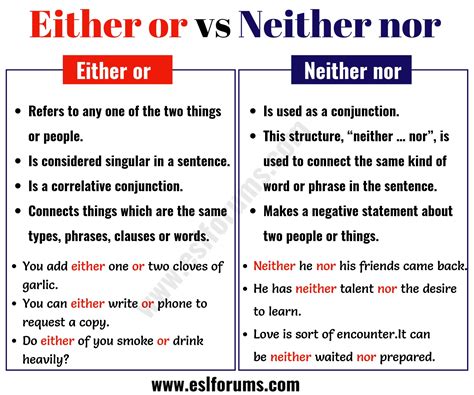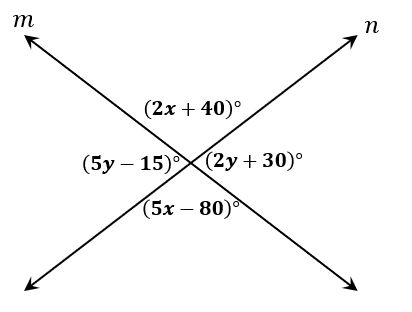Unraveling Python's List Flattening Magic
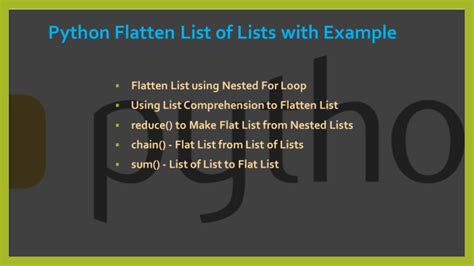
Welcome to the world of Python, where list manipulation is an art, and list flattening is a powerful tool that can transform your data structures. Python's list flattening technique allows you to merge nested lists into a single, flat list, making complex data more manageable and easier to work with. In this comprehensive guide, we will delve into the intricacies of list flattening, explore its applications, and uncover the magic behind this essential Python feature.
The Art of List Flattening

List flattening is a fundamental concept in Python that involves converting a nested list structure into a single-level list. This process simplifies data organization, enhances readability, and enables efficient data manipulation. By flattening lists, you gain the ability to perform operations on the entire dataset as a whole, rather than navigating through complex hierarchies.
Consider a scenario where you have a list of student records, and each record contains a list of their course grades. To analyze the overall performance of a student body, you would need to access and manipulate individual grades. List flattening comes to the rescue by transforming this hierarchical data into a flat structure, making it more convenient to calculate averages, identify top performers, and perform various statistical analyses.
The Recursive Approach
One of the most common techniques for list flattening is recursion. Recursion involves defining a function that calls itself to solve a problem. In the context of list flattening, a recursive function can traverse the nested list structure, adding each element to a flat list.
def flatten_list(nested_list):
flat_list = []
for element in nested_list:
if isinstance(element, list):
flat_list.extend(flatten_list(element))
else:
flat_list.append(element)
return flat_list
The flatten_list function takes a nested list as input and returns a flat list. It uses a for loop to iterate through each element of the nested list. If an element is itself a list, the function calls itself recursively, passing the nested list as an argument. This process continues until all nested lists are flattened, and the function returns a single flat list.
For example, let's consider the following nested list:
nested_list = [1, [2, 3], [4, [5, 6]], 7]
Applying the flatten_list function to this nested list yields:
flattened_list = flatten_list(nested_list)
print(flattened_list) # Output: [1, 2, 3, 4, 5, 6, 7]
The Generator Expression Approach
Another elegant way to flatten lists in Python is through generator expressions. Generator expressions are concise and memory-efficient, making them an excellent choice for large datasets.
def flatten_list_generator(nested_list):
for element in nested_list:
if isinstance(element, list):
yield from flatten_list_generator(element)
else:
yield element
The flatten_list_generator function is a generator that flattens a nested list using a generator expression. It uses the yield from statement to recursively flatten nested lists. This approach avoids creating intermediate lists, making it more memory-efficient for large datasets.
To use this generator, you can convert it into a list using the list function:
nested_list = [1, [2, 3], [4, [5, 6]], 7]
flattened_list = list(flatten_list_generator(nested_list))
print(flattened_list) # Output: [1, 2, 3, 4, 5, 6, 7]
Applications and Benefits of List Flattening
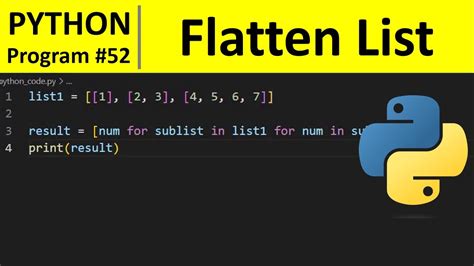
List flattening finds its applications in various domains, enhancing data manipulation and analysis. Here are some key advantages and use cases:
Data Visualization
When working with data visualization libraries like matplotlib or seaborn, flat lists are often required for plotting. List flattening ensures that your data is in the correct format, making it easier to create informative and visually appealing charts and graphs.
Machine Learning and AI
In the realm of machine learning and artificial intelligence, list flattening is crucial for preparing data for training and testing models. By flattening lists, you can convert hierarchical data into a format that machine learning algorithms can easily process, leading to more accurate predictions and insights.
Database Management
When interacting with databases, list flattening simplifies data insertion and retrieval. By converting nested lists into flat lists, you can efficiently store and retrieve data, improving the performance and scalability of your database operations.
Performance Optimization
List flattening can significantly enhance the performance of your Python scripts. By reducing the complexity of your data structures, you can optimize memory usage and improve the efficiency of your algorithms. This is especially beneficial when working with large datasets or resource-constrained environments.
| Data Structure | Flattened List |
|---|---|
| [1, [2, 3], [4, [5, 6]], 7] | [1, 2, 3, 4, 5, 6, 7] |
| [[1, 2], [3, 4], [5, 6]] | [1, 2, 3, 4, 5, 6] |
| ["A", ["B", "C"], ["D", ["E", "F"]]] | ["A", "B", "C", "D", "E", "F"] |
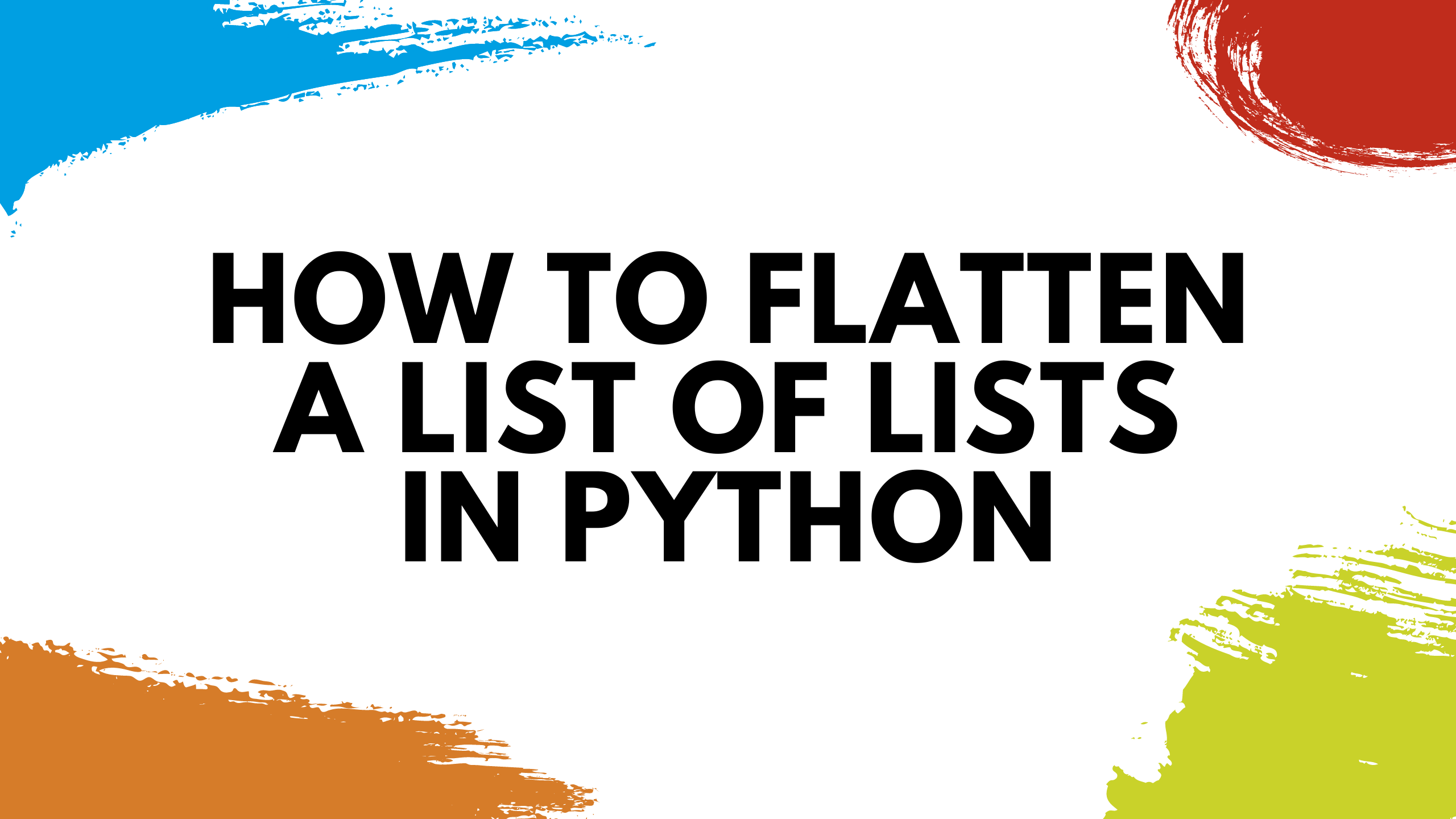
Advanced List Flattening Techniques
While the recursive and generator expression approaches are powerful, Python offers additional techniques for list flattening. Let’s explore some advanced methods:
List Comprehensions
List comprehensions are a concise and powerful way to create new lists based on existing ones. They can be used to flatten nested lists efficiently. Here’s an example using a list comprehension:
nested_list = [1, [2, 3], [4, [5, 6]], 7]
flattened_list = [element for sublist in nested_list for element in sublist]
print(flattened_list) # Output: [1, 2, 3, 4, 5, 6, 7]
Itertools Library
The itertools library in Python provides a range of tools for working with iterators and generating complex data structures. The chain function from itertools can be used to flatten nested lists:
import itertools
nested_list = [1, [2, 3], [4, [5, 6]], 7]
flattened_list = list(itertools.chain(*nested_list))
print(flattened_list) # Output: [1, 2, 3, 4, 5, 6, 7]
map() and filter() Functions
The map and filter functions in Python can also be used to flatten nested lists. The map function applies a function to each element of an iterable, while the filter function creates a new iterable with elements that satisfy a given condition. By combining these functions, you can achieve list flattening:
nested_list = [1, [2, 3], [4, [5, 6]], 7]
flattened_list = list(filter(None, map(flatten_element, nested_list)))
def flatten_element(element):
if isinstance(element, list):
return list(filter(None, map(flatten_element, element)))
else:
return element
print(flattened_list) # Output: [1, 2, 3, 4, 5, 6, 7]
Best Practices and Considerations
When working with list flattening, it’s essential to consider a few best practices to ensure efficient and effective code:
- Performance Optimization: While list flattening simplifies data, it can also introduce performance overhead. For large datasets, consider using memory-efficient techniques like generator expressions or the itertools library.
- Functionality vs. Readability: Choose the flattening technique that best suits your use case. Recursion is powerful but can lead to complex code. List comprehensions and generator expressions offer a more concise approach, improving code readability.
- Error Handling: When working with user-generated data, be mindful of potential errors. Handle cases where nested lists may contain non-list elements or unexpected data types to ensure your code remains robust.
Conclusion

Python’s list flattening magic is a powerful tool for simplifying and organizing data. By unraveling the intricacies of list flattening, you can unlock new possibilities for data manipulation and analysis. From recursive functions to generator expressions, Python provides a range of techniques to flatten nested lists and enhance your Python programming skills.
As you continue your Python journey, remember that list flattening is a fundamental concept with wide-ranging applications. By mastering this technique, you'll be better equipped to tackle complex data challenges and create efficient, elegant solutions.
Frequently Asked Questions
Can list flattening be applied to other data structures like tuples or sets?
+
Yes, list flattening can be applied to other data structures like tuples and sets. However, it’s important to note that tuples are immutable, so you’ll need to convert them to lists before flattening. Sets, on the other hand, don’t preserve the order of elements, so flattening a set may not always produce the desired result.
Are there any performance considerations when using list flattening on large datasets?
+
Yes, when working with large datasets, the choice of list flattening technique becomes crucial. Recursive functions and list comprehensions may consume more memory, while generator expressions and the itertools library offer more memory-efficient solutions. Consider the trade-offs between functionality and performance when selecting a flattening approach.
Can list flattening be applied to nested dictionaries or other complex data structures?
+
List flattening is primarily designed for nested lists. Flattening nested dictionaries or other complex data structures would require a different approach. You might need to define custom functions or use libraries like pandas or json_normalize to handle such cases.
What are some common mistakes to avoid when flattening lists in Python?
+
Some common mistakes to avoid include forgetting to handle non-list elements within nested lists, not considering the order of elements in sets when flattening, and not optimizing memory usage for large datasets. Always ensure your code is robust and handles various data scenarios.
Are there any libraries or tools that can assist with list flattening in Python?
+
Yes, Python has several libraries that can assist with list flattening. The pandas library, for example, provides the DataFrame.flatten() method to flatten a DataFrame’s columns. Additionally, the json_normalize function from pandas can be used to flatten nested JSON-like data structures.

